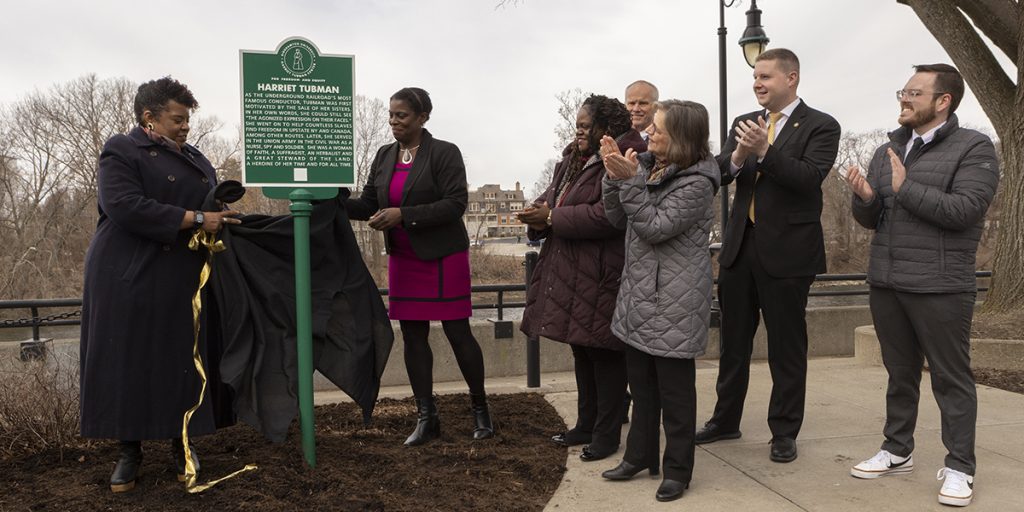The Binghamton Freedom Trail has begun, with its first marker revealed.
The marker was unveiled on the morning of March 10, Harriet Tubman day. With the first marker placed in front of Binghamton University’s Downtown Center (UDC), the trail will continue with the placement of 11 other markers around Binghamton. When completed, the Freedom Trail Markers will be placed in various iconic Binghamton City landmarks, from the Phelps Mansion to the Martin Luther King Jr. statue.
The Freedom Trail Project was assisted by a $400,000 grant from New York State Gov. Kathy Hochul’s toward BU’s Harriet Tubman Center for Freedom and Equity. The trail, which will recognize Binghamton’s history of civil rights, acknowledges Binghamton’s integral role as a part of the Underground Railroad. A nod to the city’s abolitionist history, each of the 12 markers on the trail identifies major sites that were once visited by Underground Railroad conductors and abolitionists like Tubman. Tubman will also be memorialized through a statue at the UDC.
Binghamton Mayor Jared Kraham shared some words about this new project, articulating his optimism for the future through the new initiative.
“The statue and the Downtown Binghamton Freedom Project Trail project as a whole, bring the important work of the Tubman Center into the City of Binghamton, making it visible and accessible to residents and visitors,” Kraham wrote in an email. “It is my hope that for decades to come this new statue and this Freedom Trail will educate and inspire the next generations of changemakers.”
Kraham acknowledged Binghamton’s “infamous history with racism and hate” but asserted the positive role the city has played throughout the years.
“But Binghamton’s past is so much richer on the right side of history — that history needs to be told and resourced and celebrated,” Kraham wrote. “The new Freedom Trail will change how Binghamton, as a community, represents itself and our values in the public sphere.”
Binghamton was home to people and places that had a remarkable place in history, like figures in the women’s suffrage movement, the fight for civil rights and the abolitionist movement, which the Freedom Trail honors according to Kraham.
Anne Bailey, director of the Harriet Tubman Center for Freedom and Equity, spoke at the unveiling of the statue this past week, citing a lesson she learned from Tubman.
“The word is vision — this is the word inspired by Tubman that I carry with me everyday,” Bailey said. “She had a vision, and thus, she had a purpose for her life. Vision gives you purpose and it gives you the ability to work and to live for something bigger than yourself, and there is nothing greater than that.”
Bailey gave a message to the audience, reminiscing on what she learned from Tubman’s life.
“If you do not know what that vision is yet, then that’s OK — seek it,” Bailey said. “Seek vision and purpose as Harriet Tubman did and maybe a couple hundred years later they’ll still be calling her name.”
Five selected artists are currently under consideration to design the statue, and their designs are slated to be reviewed at UDC on April 20. Public input will finalize the selections, and it will be erected to cement New York state’s past as a leader in the abolitionist movement.
Kelly Mui, a freshman majoring in integrative neuroscience, expressed anticipation for the statue and the representation it would provide.
“This statue would bring awareness to an underrepresented community here, and I think that opportunity to provide some exposure would be a great addition to the city,” Mui said. “Binghamton has a long and underrated history, and this is an amazing chance to showcase the positives through a leading historical figure that has been important for the city.”
Daniel Owens, a freshman majoring in integrative neuroscience, noted the historical importance of having such a statue in Binghamton, recognizing both the city’s past and present.
“I’ve heard a lot about the negative history here in Binghamton, but I’ve also come to learn that the city has played a critical role in many leading movements,” Owens said. “I hope that the statue and the Freedom Trail will provide some much needed exposure that paints the city’s past in a good light and for it to highlight marginalized communities here.”



